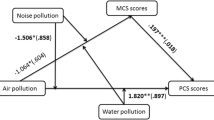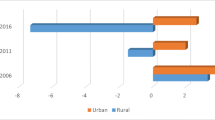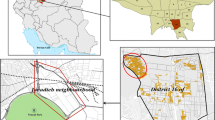Abstract
To compare QOL among rural people living in three different industrial areas and one non-industrial area in southern Thailand. A questionnaire based on the WHOQOL-BREF with environmental assessment was initially developed. After consultation with experts and pilot study, it was tested to check internal reliability and further modified as necessary. The final version was then used to survey residents of three rural areas close to organic industries, a gas refinery, and an electricity power plant and residents from a non-industrial area. The developed scale has acceptable reliability coefficient (0.76). The overall QOL scores among those living in all study areas were high (mean > 3.75 out of 5). Only environmental QOL domain was slightly low (mean = 3.7) among these living close to the gas refinery area where people were distinctively disturbed by various types of pollution. Unpleasant odours were reported by residents living close to the power plant and areas of organic industries. After adjustment for age, education, income level and marital status, the residents of industrial areas were more than two times likely to have an unfavorable QOL. The level of pollution in the study industrial area should be reduced.
Similar content being viewed by others
Abbreviations
- QOL:
-
Quality of life
- WHOQOL-BREF:
-
The World Health Organization Quality of Life-BREF
References
Afroz, R., Hassan, M. N., & Ibrahim, N. A. (2003). Review of air pollution and health impacts in Malaysia. Environmental Research, 92(2), 71–77.
Domac, J., Richards, K., & Risovic, S. (2005). Socio-economic drivers in implementing bioenergy projects. Biomass and Bioenergy, 28(2), 97–106.
Ibrahim, M. F., & Chung, S. W. (2003). Quality of life of residents living near industrial estates in Singapore. Social Indicators Research, 61(2), 203–225.
Jadsri, S., Singhasivanon, P., Kaewkungwal, J., Sithiprasasna, R., Siriruttanapruk, S., & Konchom, S. (2006). Spatio-temporal effects of estimated pollutants released from an industrial estate on the occurrence of respiratory disease in Maptaphut Municipality, Thailand. International Journal of Health Geographics, 5(1), 48–60.
Lauritsen, J. M., & Bruus, M. (2004). A comprehensive tool for validated entry and documentation of data. Odense, Denmark: The EpiData Association.
MacKerron, G., & Mourato, S. (2009). Life satisfaction and air quality in London. Ecological Economics, 68(5), 1441–1453.
Mutatkar, R. K. (1995). Public health problems of urbanization* 1. Social Science and Medicine, 41(7), 977–981.
Pacione, M. (2003). Urban environmental quality and human wellbeing—A social geographical perspective. Landscape and Urban Planning, 65(1–2), 19–30.
Peluso, M., Srivatanakul, P., Munnia, A., Jedpiyawongse, A., Ceppi, M., Sangrajrang, S., et al. (2010). Malondialdehyde–deoxyguanosine adducts among workers of a thai industrial estate and nearby residents. Environmental Health Perspectives, 118(1), 55.
Peluso, M., Srivatanakul, P., Munnia, A., Jedpiyawongse, A., Meunier, A., Sangrajrang, S., et al. (2008). DNA adduct formation among workers in a Thai industrial estate and nearby residents. Science of the Total Environment, 389(2–3), 283–288.
R Development Core Team. (2009). R: A language and environment for statistical computing. R foundation for statistical computing.
Rehdanz, K., & Maddison, D. (2008). Local environmental quality and life-satisfaction in Germany. Ecological Economics, 64(4), 787–797.
Robin, M., Matheau-Police, A., & Couty, C. (2007). Development of a scale of perceived environmental annoyances in urban settings. Journal of Environmental Psychology, 27(1), 55–68.
Sadorsky, P. (2001). Risk factors in stock returns of Canadian oil and gas companies. Energy Economics, 23(1), 17–28.
Santos, L. D., Martins, I., & Brito, P. (2007). Measuring subjective quality of life: A survey to porto’s residents. Applied Research in Quality of Life, 2(1), 51–64.
Seaton, A. (1996). Particles in the air: the enigma of urban air pollution. Journal of the Royal Society of Medicine, 89(11), 604–607.
The WHOQOL Group. (1998). Development of the World Health Organization WHOQOL-BREF quality of life assessment. Psychological Medicine, 28(03), 551–558.
van Kamp, I., Leidelmeijer, K., Marsman, G., & de Hollander, A. (2003). Urban environmental quality and human well-being: Towards a conceptual framework and demarcation of concepts; a literature study. Landscape and Urban Planning, 65(1–2), 5–18.
Wing, S., Horton, R. A., Marshall, S. W., Thu, K., Tajik, M., Schinasi, L., et al. (2008). Air pollution and odor in communities near industrial swine operations. Environmental Health Perspectives, 116(10), 1362.
Wong, C. (2001). The Relationship between quality of life and local economic development: An empirical study of local authority areas in England. Cities, 18(1), 25–32.
Acknowledgments
This study was funded by Discipline of Excellence, Epidemiology Unit, Prince of Songkla University, Thailand which is partially supported by the National Science and Technology Development Agency: NSTDA. We are grateful to Chana hospital staff that facilitated the data collection and to all research assistants and study participants.
Author information
Authors and Affiliations
Corresponding author
Rights and permissions
About this article
Cite this article
Sopsuk, J., Chongsuvivatwong, V., Sornsrivichai, V. et al. Development and Application of Environmental Quality of Life Scale Among People Residing Near Three Types of Industrial Areas, Southern Thailand. Soc Indic Res 110, 863–872 (2013). https://doi.org/10.1007/s11205-011-9961-z
Accepted:
Published:
Issue Date:
DOI: https://doi.org/10.1007/s11205-011-9961-z




